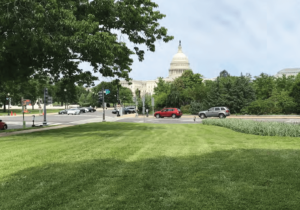When the National Geographic Society revealed its plans to overhaul the main entrance plaza to its designed Washington, D.C. campus last summer, MARABAR, an evocative sculptural installation consisting of five massive mahogany boulders flanking a long and narrow reflecting pool, was conspicuously absent from design renderings of the revamped landscape.
Completed by lauded New York-based artist Elyn Zimmerman in 1984, MARABAR has long served as the dramatic focal point for National Geographic’s existing modernist public plaza—a heavily trafficked space designed by David Childs of Skidmore, Owings & Merrill (SOM) in collaboration with landscape architect James Urban—although it would appear that it will not serve a similar—or any—function within Hickock Cole’s 21st-century vision for the pavilion, which is currently under review by the District of Columbia’s Department of Consumer and Regulatory Affairs.
Nonprofit advocacy group The Cultural Landscape Foundation (TCLF) first sounded the alarm regarding MARABAR’s MIA status in March, swiftly adding the site to its Landslide program of under-threat landscapes of cultural significance. The TCLF also implored the concerned public to contact D.C.’s Historic Preservation Review Board (HPRB), urging them to “revisit the plans for the new pavilion in order to take a full account of its effect on the sculpture.”
In the weeks since MARABAR was granted with “endangered” status by TCLF, the pressure campaign to preserve the sculpture at its current site has gained notable traction. On May 8, the New York Times published a feature on the growing D.C. preservation controversy, noting that over two dozen letters of opposition from artists, architects, critics, museums leaders, and others “who fear the loss of an important work” had been submitted to the HPRB. Writers of these letters have included, among others, Childs, New Yorker writer Adam Gopnik, architect Frederick Fisher, artist and designer Mary Miss, architectural historian and critic Marc Treib, Penny Balkin Bach, the executive director and chief curator of the Association for Public Art, and Jennifer Duncan, director of the Foundation for Art and Preservation in Embassies.
In his letter, Childs urged the board to “preserve her [Zimmerman’s] sculpture as part of whatever modifications are being contemplated.”
“Washington is noted for its public art, and Marabar is one of its finest examples,” Childs continued. “I am certain that if the National Geographic’s current design team were asked to respect Elyn’s sculpture the way we had been asked to respect Hubbard Hall and the headquarters building on the National Geographic’s campus, they could devise an accommodating solution that would again evoke the Board’s enthusiastic applause.”
Witold Rybcznski: “I served w/ Zimmerman on the Commission of Fine Arts in the early 2000s. At the time we were reviewing the Martin Luther King Jr. Memorial, & we visited Marabar, whose split & polished boulder is an artistic precursor to that memorial.” https://t.co/NNKkf6iJpD pic.twitter.com/pM8tkV7awc
— Charles Birnbaum (@TCLFdotORG) May 7, 2020
Adam Weinberg, director of the Whitney Museum of American Art in New York City, was also among those to express his concern.
“I know that destruction is not the intent of National Geographic,” Weinberg wrote in his letter. “I do however ask that they consider other options. Not only do I believe that it would be the right thing—for Zimmerman and art history—but it would be an important signal and reaffirmation of National Geographic’s own values as a leading organization committed to protecting the great wonders of the world, be they woman-made or natural.”
Officials with National Geographic opted not to be interviewed by the Times but relayed that the absence of MARABAR in the plaza redesign was intentional and not some sort of egregious oversight. The society also promised to pay for the boulders’ removal and relocation, which would be carried out in a “respectful and appropriate manner.” It’s unclear if that relocation would take place within the National Geographic campus.
Zimmerman herself has also made clear her displeasure with the idea of her work being removed from the site, and, per the Times, “did not take it seriously at first because so much work had gone into preparing the site for its installation” when she first got wind of a potential plaza redesign in 2017.
“The largest of those boulders weighs a quarter of a million pounds,” she explained to the Times, expressing concern with how cumbersome, not to mention potentially damaging to the surrounding buildings, it will be to remove and relocate the boulders while keeping them fully intact. “They’re going to have to dynamite the thing out of there.”
The HPRB plans to address the concerns brought forth by TCLF and others at a meeting scheduled for May 28.











